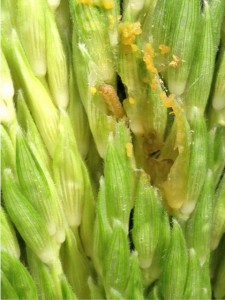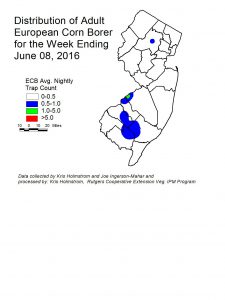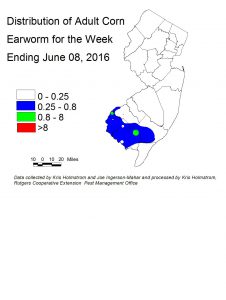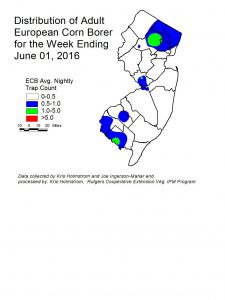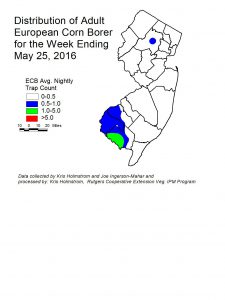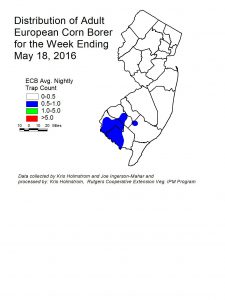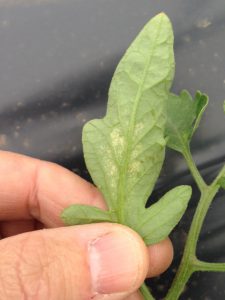Sweet Corn
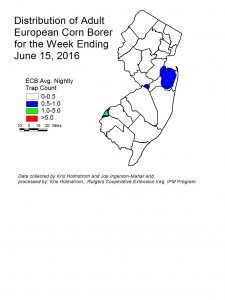 Catches of European corn borer (ECB) have declined through much of the state. Remaining areas of highest activity include parts of Monmouth, Mercer and Salem counties (see ECB map). ECB infestations are now rising in sweet corn plantings, but are well below normal levels. Feeding ranges from single digits to 20% in areas where IPM personnel are operating, but many plantings have no detectable feeding at all. Be sure to begin monitoring plantings for ECB feeding while they are still in the whorl stage. Consider treating when the number of infested plants in a 50 plant sample exceeds 12%. Feeding in the whorl stage will appear as numerous small holes (called “shot-hole”) on leaves, with damage present on consecutively younger leaves. As plants progress to pre-tassel and beyond, the actual larvae may be found in or on the emerging tassels (see photo). Any planting remaining at or above threshold as it proceeds to full tassel should be treated, as this is the last stage at which ECB larvae will be exposed and vulnerable to insecticidal sprays. Often, early sweet corn plantings suffer from “split set”, in which germination does not occur in a uniform
Catches of European corn borer (ECB) have declined through much of the state. Remaining areas of highest activity include parts of Monmouth, Mercer and Salem counties (see ECB map). ECB infestations are now rising in sweet corn plantings, but are well below normal levels. Feeding ranges from single digits to 20% in areas where IPM personnel are operating, but many plantings have no detectable feeding at all. Be sure to begin monitoring plantings for ECB feeding while they are still in the whorl stage. Consider treating when the number of infested plants in a 50 plant sample exceeds 12%. Feeding in the whorl stage will appear as numerous small holes (called “shot-hole”) on leaves, with damage present on consecutively younger leaves. As plants progress to pre-tassel and beyond, the actual larvae may be found in or on the emerging tassels (see photo). Any planting remaining at or above threshold as it proceeds to full tassel should be treated, as this is the last stage at which ECB larvae will be exposed and vulnerable to insecticidal sprays. Often, early sweet corn plantings suffer from “split set”, in which germination does not occur in a uniform
fashion. The result is a planting where all plants do not reach full tassel at the same time. This situation may require an extra tassel spray if there are several days difference in the time full tassel is reached on a significant number of the plants. Insecticides that are acceptable in organic production include the spinosyn based material Entrust (IRAC-5) and Dipel (IRAC-11a). The 10G formulation of Dipel is particularly useful when granules can be dropped or broadcast such that they get into the whorls of corn plants. See the 2016 Commercial Vegetable Recommendations Guide for more insecticide choices.
The highest nightly ECB catches for the previous week are as follows:
| Allentown 1 | Eldora 1 | Lawrenceville 1 |
| Cinnaminson 1 | Folsom 1 | Pedricktown 1 |
| Denville 1 | Hackettstown 1 | Princeton 1 |
| Downer 1 | Jones Island 1 | Sergeantsville 1 |
